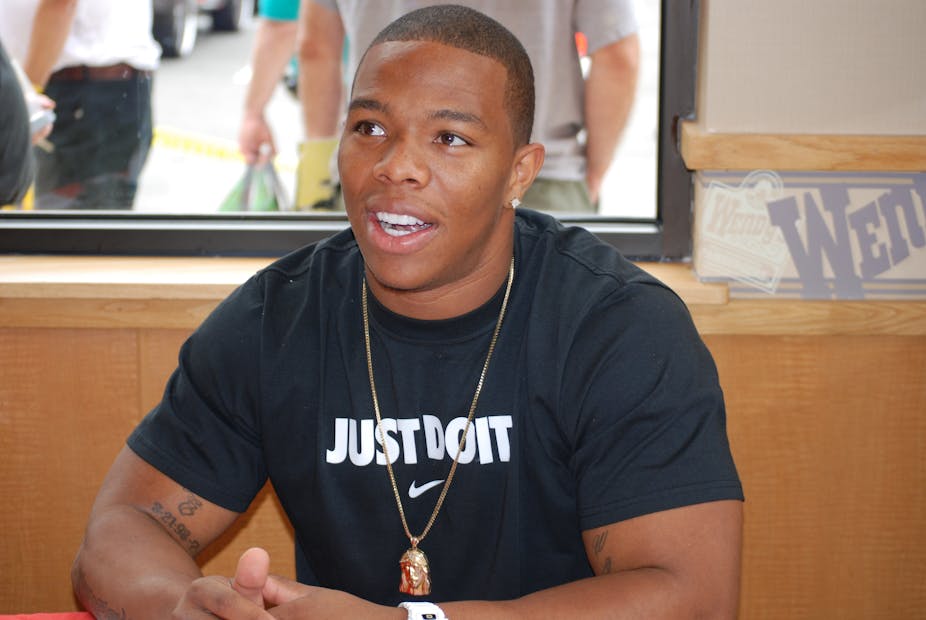Another day, another headline about a sports player and domestic violence. LA Kings player Slava Voynov was arrested on suspicion of domestic violence on October 19, and has been suspended by the NHL. This comes only a two months after NFL player Ray Rice was suspended after a video of him knocking out his then fiancee surfaced online.
Violence against women in sports – ranging from domestic abuse to gang rape – is a long-standing problem that remained invisible until the 1980s. Before then, when the connection between violence and sports was addressed, it was rule-breaking clashes on the playing field and hooliganism in the stands that attracted attention.
The fact that members of male sports teams were more likely to be perpetrators of violence eventually led to increased awareness and the introduction of codes of conduct, mentoring programs and education interventions. Yet the problem persists.
However, as Robin Warshaw pointed out in her 1988 book, I Never Called it Rape, statistics need to be treated with caution. The media paid more attention to sex-related offenses committed by black athletes than by “average” white students, and female victims were less likely to report attacks by popular varsity athletes than by non-athletes.
Having first examined these trends in the early 1990s, I find it disheartening to see the limited progress of the past two decades, as celebrity athletes continue to develop an inflated sense of personal entitlement, fostered by a system that rewards sporting success at all costs.
How it happens
The process begins at an early age: athletic ability represents a sure route to popularity among peers, and male athletes’ sexual prowess becomes the currency of the locker room. Socialization into the world of competitive team sports in high school often involves hazing rituals with components that symbolize sexual humiliation and violence against women, including so-called “sodomy hazing”, thus setting the stage for actual violence against women.
In 1989, three players from Glen Ridge High School’s football team sexually assaulted a developmentally delayed 17-year-old girl. The same New Jersey high school had been investigated back in 1941, when a sociological study that concluded there was an overemphasis on producing winning teams at the expense of instilling important social values.
These boys join the ranks of prominent male athletes whose careers led to tragic consequences for girls and women in their lives: OJ Simpson, Mike Tyson, Oscar Pistorius, and Ray Rice.
With black players now accounting for 76% of NBA teams and 66% of the NFL, it is not surprising that most of the high-profile incidents involve black men. In contrast to the US situation, increasing numbers of Canada’s white professional and university ice hockey players have been charged with violence against women in the past two decades, but with limited media exposure of their crimes.
Jeffrey Benedict’s book, Athletes and Acquaintance Rape, examined how the subculture of professional and college sports promoted violence against women, while the system protected the men who committed this violence from punishment and conviction. Preferential treatment of male athletes encompassed both material and intangible benefits, including limitless sex with female “groupies”. The view of these women and, by extension, all women, as disposable, even sub-human, contributed further to their sense of entitlement.
The hero myth
Public adoration of professional athletes appears universal, despite the frequency with which they manage to shatter the illusion that they are heroes.
The mass media and the viewing public are fickle in their allegiances, apparently gaining almost as much satisfaction from these men’s fall from grace as from their initial rise to fame. Yet promoters continue to use these athletes as role models for educational programs.
When NBA player Charles Barkley famously rejected the role of role model, critics condemned him for a position that other athletes would have done well to emulate.
Violence is an intrinsic part of men’s team sports, and most celebrity athletes are not famous for marital fidelity or clean living. Yet they continue to be treated as positive examples for children and youth, with their athletic performances eclipsing their frequent moral failings.
From Glen Ridge in 1989 to the NFL in 2014, all these contexts demand new attitudes, policies and practices, starting with the consistent application of criminal charges and penalties, regardless of the star status of the player.
Teachers, coaches and parents need to promote critical thinking and media literacy on the part of children and adolescents, so that they recognise how values, particularly non-violence and respect for others, should shape behaviour on and off the field. If we leave moral education in the hands of multinational sporting goods companies, we cannot expect the next generation of male athletes to respect women.
This piece is part of a global series, Domestic violence and sports, which examines how different sports across the world are dealing with the issues of family violence and respect for women.

